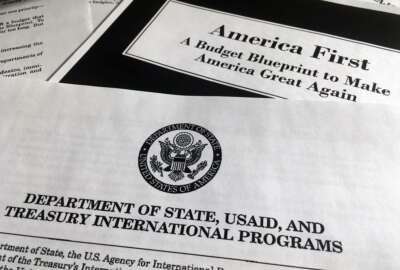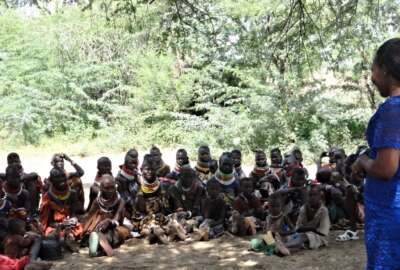
Trump releases final 2018 budget proposal, touts $3.6T in spending cuts over 10 years
Many of the ideas President Donald Trump outlined in his March budget blueprint remain the same in his final budget proposal, which he released Tuesday. But federal...
On first glance, President Donald Trump’s first full budget proposal for fiscal 2018 looks similar to the ideas he offered in his “skinny budget” proposal from March.
Many of the themes are similar, and the expected spending boosts to fund the President’s priorities on national security, defense, homeland security, the southern border and veterans all remain intact.
The Trump administration is championing an evidence-based approach to budgetary decisions.
“We are no longer going to measure compassion by the number of programs or the number of people on those programs,” Office of Management and Budget Director Mick Mulvaney told reporters during a May 22 briefing on the budget. “We’re going to measure compassion and success by the number of people we help get off of those programs to get back in charge of their own lives. We’re not going to measure our success by how much money we spend but by how many people we actually help.”
But beyond the additional details, federal employees will notice other proposals that are new — and have the potential to impact them directly.
“These proposals complement ongoing efforts — including a roll-back of burdensome regulations, the reorganization of federal agencies and the reduction of the federal civilian workforce — that are a part of a new approach to support American workers and job creators,” the 2018 budget summary said.
The budget, titled “The New Foundation for American Greatness,” proposes $607 billion in defense discretionary spending and $560 billion in non-defense discretionary spending for fiscal 2018.
The 2018 budget proposes further non-defense discretionary cuts by 2 percent over the next 10 years to balance the budget by 2027. Non-defense agencies will find those savings as they embark on the administration’s plans to reorganize government and reduce the size of the federal workforce.
It includes $3.6 trillion in spending reductions to reach a balance within 10 years. It cuts publicly held debt to 60 percent of the gross domestic product.
As the administration indicated in its “skinny budget,” Trump proposed $54 billion in reductions to non-defense discretionary spending in fiscal 2018 to offset boosts to the defense budget.
Those reductions come, in part, from changes to Medicaid, Supplemental Nutrition Assistance Program (SNAP), student loan, Earned Income Tax Credit and Child Tax Credit programs. It redirects some foreign aid spending and eliminates others. It also assumes savings from the repeal and replace of the Affordable Care Act.
Other spending reductions will come from major changes to the federal retirement system. Those changes, which Mulvaney said accounted for one of the largest areas of cost savings in the 2018 budget proposal, would eliminate the cost-of-living adjustment (COLA) for employees in the Federal Employee Retirement System (FERS), cut the Civil Service Retirement System (CSRS) COLA by 0.5 percent and require higher employee contributions to their annuities, among other changes.
In total, those federal retirement proposals would save government more than $4.1 billion in 2018 and at least $149 billion in the next 10 years.
In addition, the budget includes proposals to cut governmentwide improper payments in half through “actions to improve payment accuracy and tighten administrative controls.”
Paid parental leave
The budget also proposes a nationwide, paid parental leave program to the tune of $25 billion over 10 years, a new addition from the President’s “skinny” budget proposal from March. The program would provide six weeks of paid family leave to mothers and fathers for the birth or adoption of a new child.
“It’s a truly groundbreaking thing for this president to do and to prove to folks that we can do things like that, and we can still balance the budget,” Mulvaney said.
Some lawmakers have pushed for years for a paid parental leave program for federal employees. Reps. Carolyn Maloney (D-N.Y.) and Barbara Comstock (R-Va.) both introduced legislation this year that would provide federal employees with six weeks of leave. Maloney and House Minority Whip Steny Hoyer (D-Md.) sponsored similar legislation back in 2009, but the bill has yet to pass Congress.
Lawmakers and the National Treasury Employees Union (NTEU) said they would appeal to Ivanka Trump about the issue. The President’s daughter has been vocal on the topic of paid parental leave in the past and influenced the child care plan her father proposed in September, which would give new mothers up to six weeks of paid maternity leave.
Southern border
The Homeland Security Department is one of the only civilian agencies that could receive a spending bump under the President’s 2018 budget.
Trump’s proposal includes $2.6 billion in new infrastructure, technology and personnel to begin the President’s priorities along the southern border.
That total includes more than $300 million to recruit and hire additional border patrol agents, officers, investigators, attorneys and support staff at Customs and Border Patrol and Immigration and Customs Enforcement.
The Veterans Affairs Department will also see a budget boost.
Unauthorized programs
The Trump administration is also taking a hard look at programs that haven’t been authorized by Congress. OMB is still counting, but Mulvaney said the government spends at least $300 billion on unauthorized programs that have expired.
“If they’re not important enough for Congress to take up, are they really important for me to spend your money on? That’s a valid conversation and driving a large part of what we’re trying to do with the budget,” Mulvaney said.
Other budget proposals include Postal Service reform and a restructuring of the Consumer Financial Protection Bureau.
Latest Budget News
Trump’s “skinny” budget eliminated funding for 19 small and independent federal agencies, including the Corporation for Public Broadcasting, U.S. Trade and Development Agency and National Endowment for the Arts.
Those agencies will see cuts to the majority of their funding in the 2018 budget, Mulvaney said. Those agencies won’t see zeroes immediately.
“It’s technically not eliminated,” he said of those agencies. “There’s a little money left in the budget to allow us to wind down the federal positions.”
Mulvaney will testify in front of both House and Senate budget committees this week. As a former member of Congress, he recognized that the final budget may not contain the specific proposals the President asked for in his version.
“If Congress has a different way to get to that endpoint, God bless them, that’s great,” he said. “Do I expect them to adopt this 100 percent, wholeheartedly without any change? Absolutely not. But do I expect them to work with the administration on trying to figure out places where we’re on the same page? Absolutely.”
Copyright © 2025 Federal News Network. All rights reserved. This website is not intended for users located within the European Economic Area.
Nicole Ogrysko is a reporter for Federal News Network focusing on the federal workforce and federal pay and benefits.
Follow @nogryskoWFED






